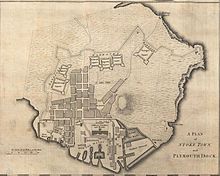Devonport, Plymouth
[3] In 1690 the Admiralty gave a contract to Robert Waters from Portsmouth to build a stone dock at Point Froward on the east bank of the Hamoaze at the mouth of the River Tamar.In July 1849, the first outbreaks in what became a cholera epidemic arose on Union Street which connected Plymouth to Devonport, and were initially attributed to blockage of several house drains during construction of a new Millbay railway station.[13] In the early nineteenth century, the dockyard lines were strengthened with stone ramparts and armed with guns, and the adjacent ditches were deepened.[17] During the millennium decade, Devonport received government New Deal for Communities funding of £48.7 million; this enabled an extensive Regeneration programme to be carried out.Where once the area was run-down, depressed, and classified as 'deprived' in many categories, the 21st-century Devonport is beginning to achieve the city's vision of ... "The recreation of Devonport as a distinct place in modern Plymouth; a vibrant self sustaining community; a place of real quality, variety and interest, the pride of residents, attractive to visitors and a model of 21st Century living, working and playing.Although there are pockets of regeneration work remaining to be completed, the waterfront district of Devonport is becoming one of the desired residential areas of the city of Plymouth.[25] Charles Darwin spent two months in Devonport from October 1831 waiting for the weather to improve so that HMS Beagle could begin its journey to South America.



HMNB DevonportOS grid referenceUnitary authorityPlymouthCeremonial countyRegionSouth WestCountryEnglandSovereign statePost townPostcode districtDialling codePoliceDevon and CornwallDevon and SomersetAmbulanceSouth WesternUK ParliamentPlymouth Sutton DevonportThree TownsEast StonehouseParliament of the United KingdomPlymouth Sutton and Devonport constituencyMember of Parliament (MP)Luke PollardLabour and Co-operative PartySamuel and Nathaniel BuckHamoazeRiver TamarDevonport ColumnguildhallJohn Foulstonmunicipal boroughMunicipal Corporations Act 1835choleraUnion StreetMillbay railway stationcounty boroughLocal Government Act 1888urban districtredoubtsPalmerston Forts around PlymouthglacisRaglan Infantry BarracksFrancis FowkeAlbert HallMount Wise, Plymouthmilitary Governornaval Commander-in-ChiefGovernment HouseAdmiralty HouseRoyal LaboratoryWoolwich Arsenalsmall-armsNew Deal for Communitiesrailway stationThe BrickfieldsPlymouth AlbionRugby uniontheatreMethodist Central HallAmateur Dramaticthe AthenaeumUTC Plymouthuniversity technical collegeDevonport ParkTorpoint Ferrynaval ratingsRoyal Naval Museumcream teasTown HallEgyptian RevivalCharles MathewsLeslie Hore-Belisha, 1st Baron Hore-BelishaMichael FootRalph Alger BagnoldGuy BurgessCambridge FiveCharles DarwinHMS Beaglejourney to South AmericaUpton, CliveHistoric EnglandNational Heritage List for EnglandWayback MachineEncyclopædia BritannicaCeremonial countyTorbayEast DevonExeterMid DevonNorth DevonSouth HamsTeignbridgeTorridgeWest DevonAshburtonAxminsterBamptonBarnstapleBidefordBovey TraceyBrixhamBuckfastleighBudleigh SaltertonChagfordChudleighChulmleighColytonCreditonCullomptonDartmouthDawlishExmouthGreat TorringtonHatherleighHolsworthyHonitonIlfracombeIvybridgeKingsbridgeKingsteigntonLyntonMoretonhampsteadNewton Abbot